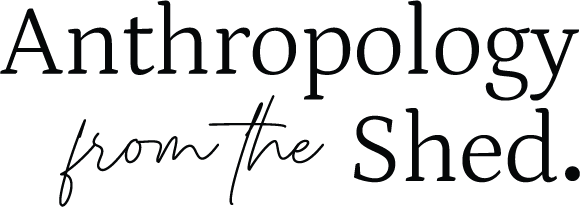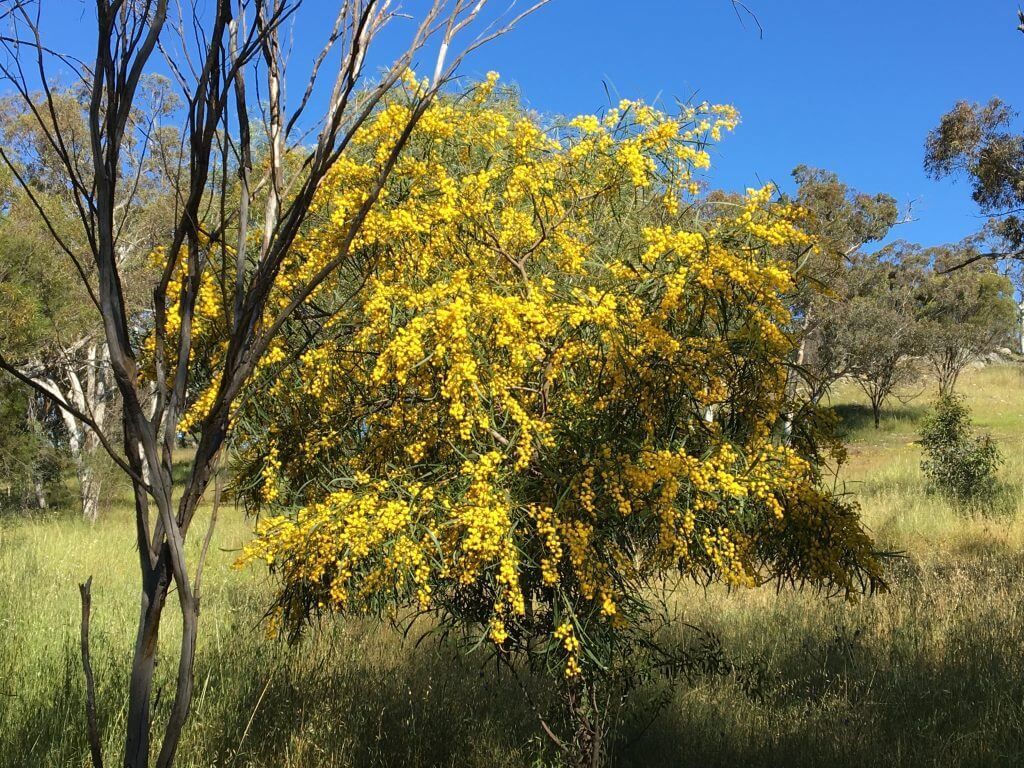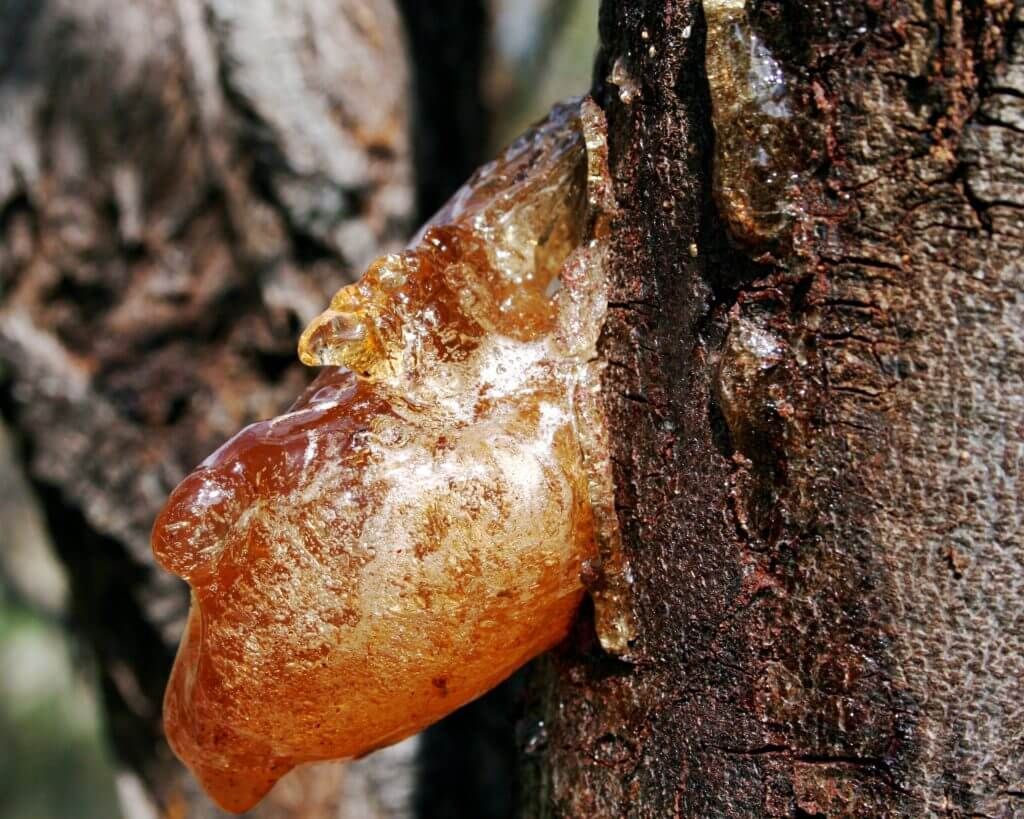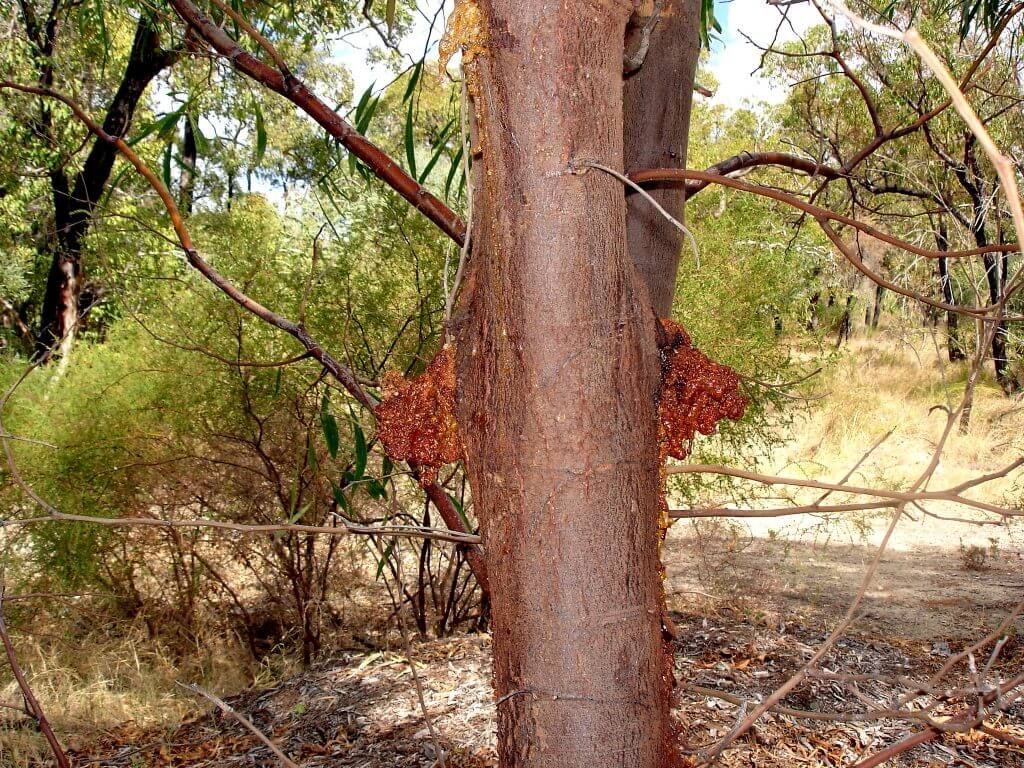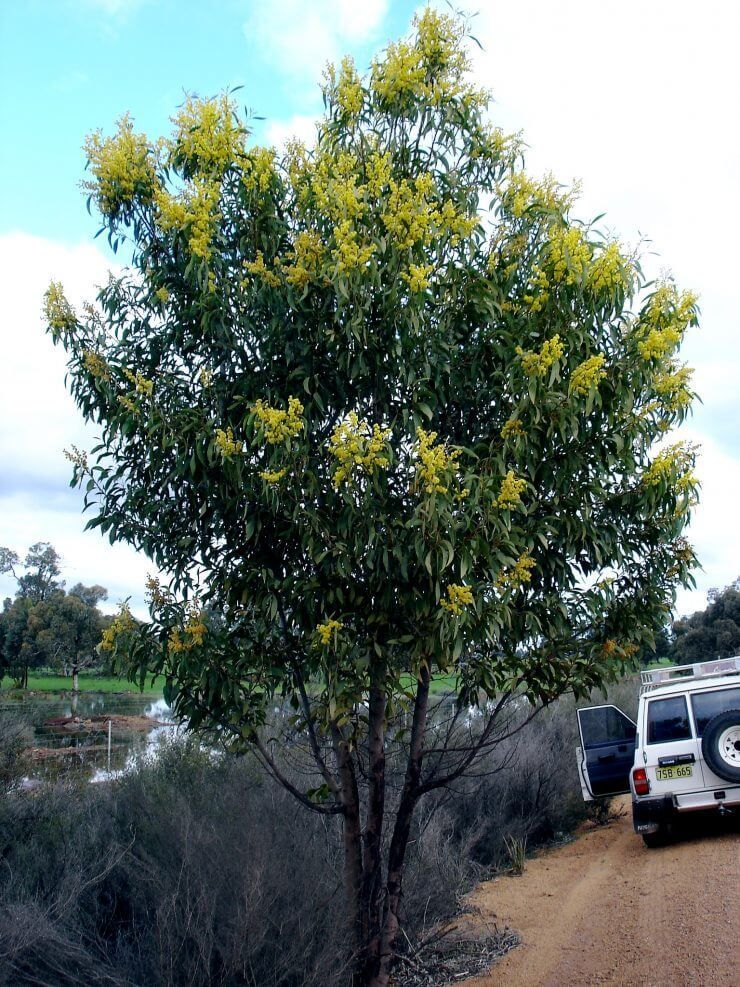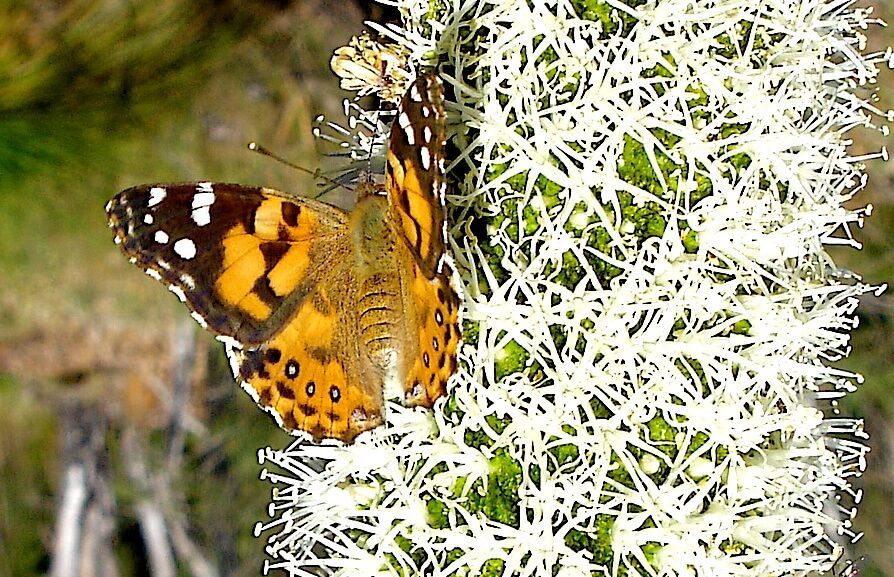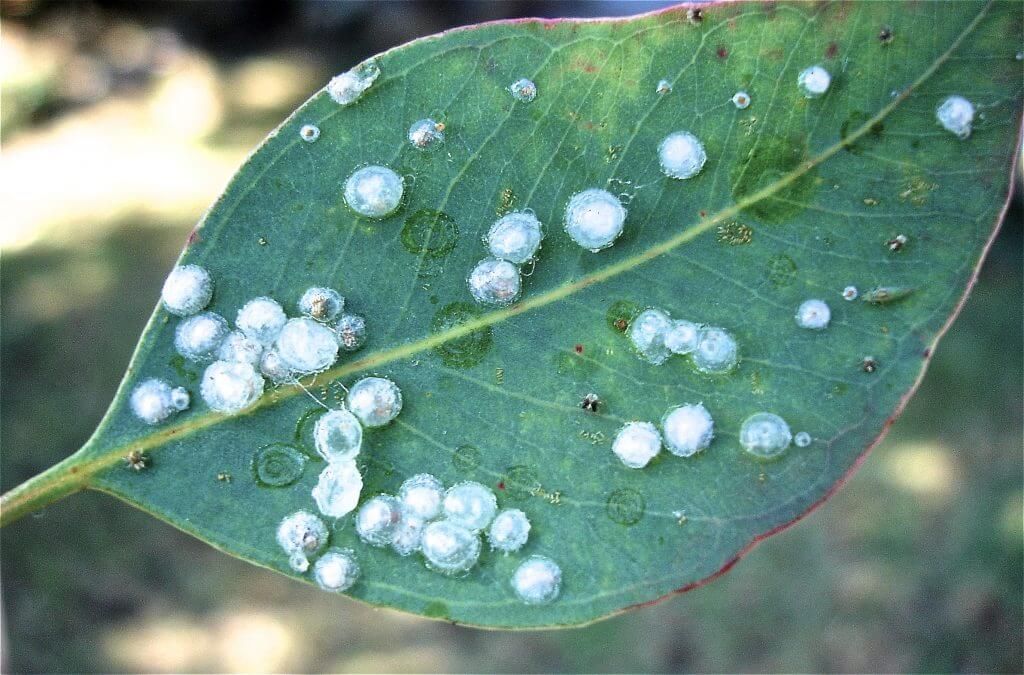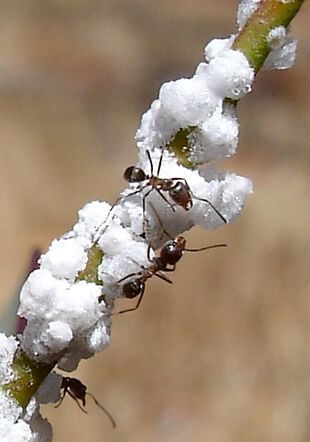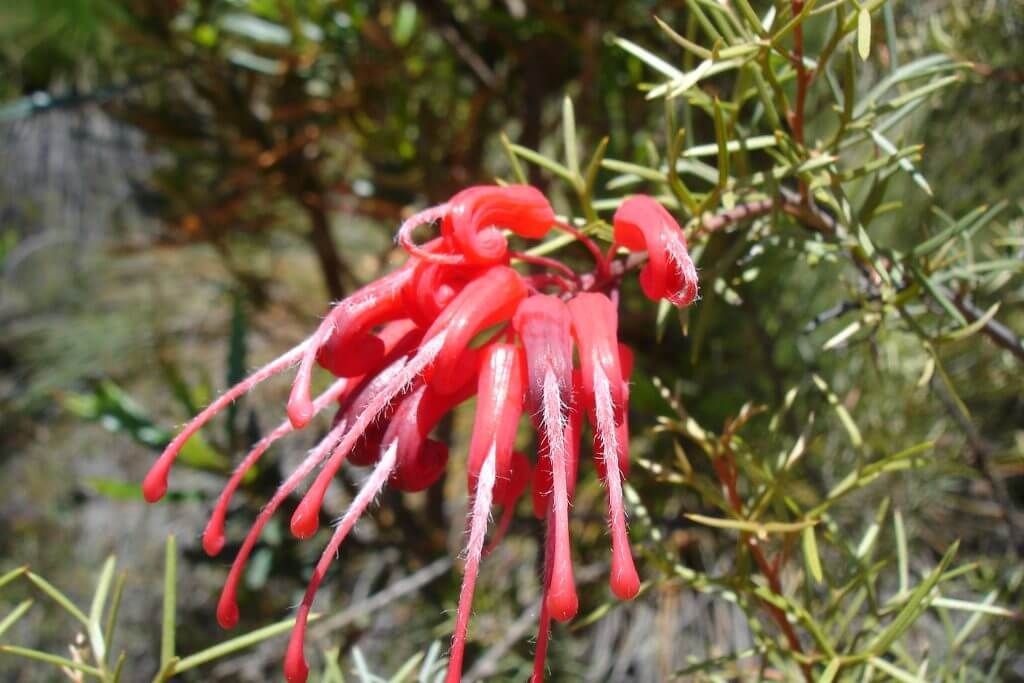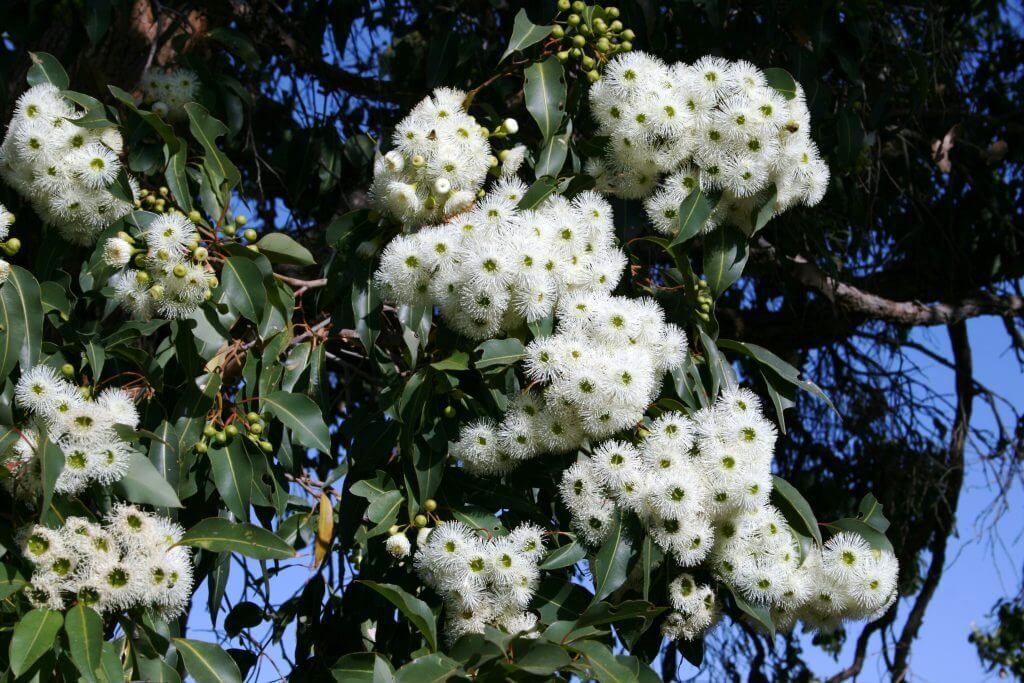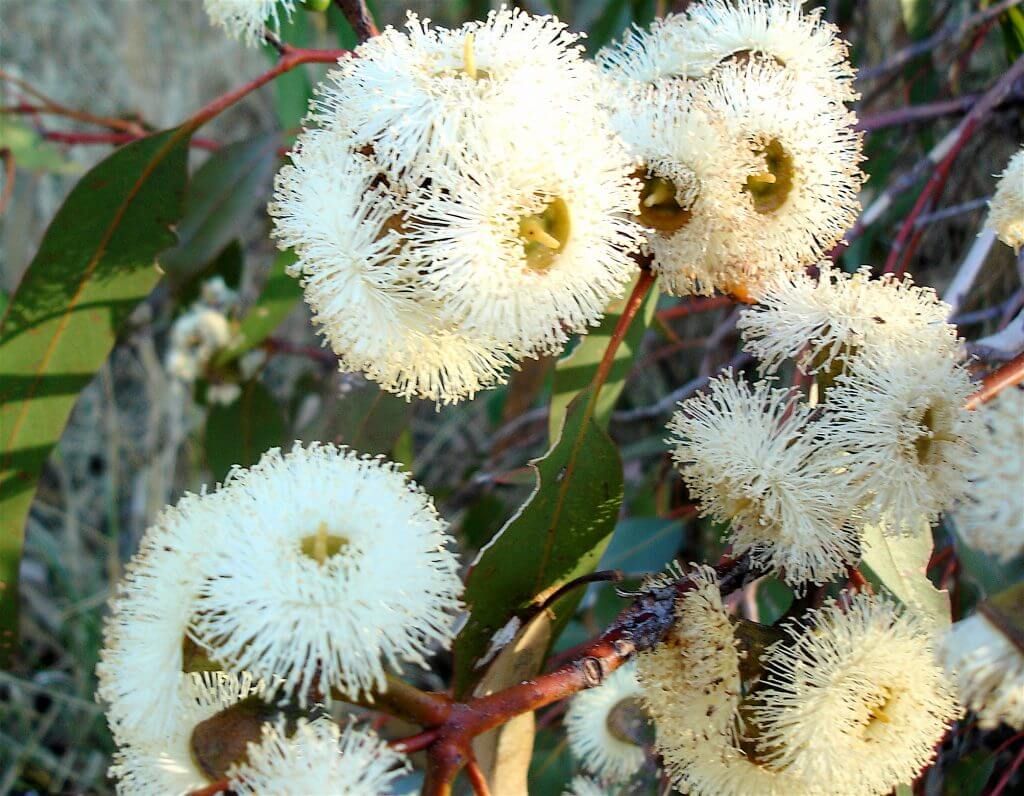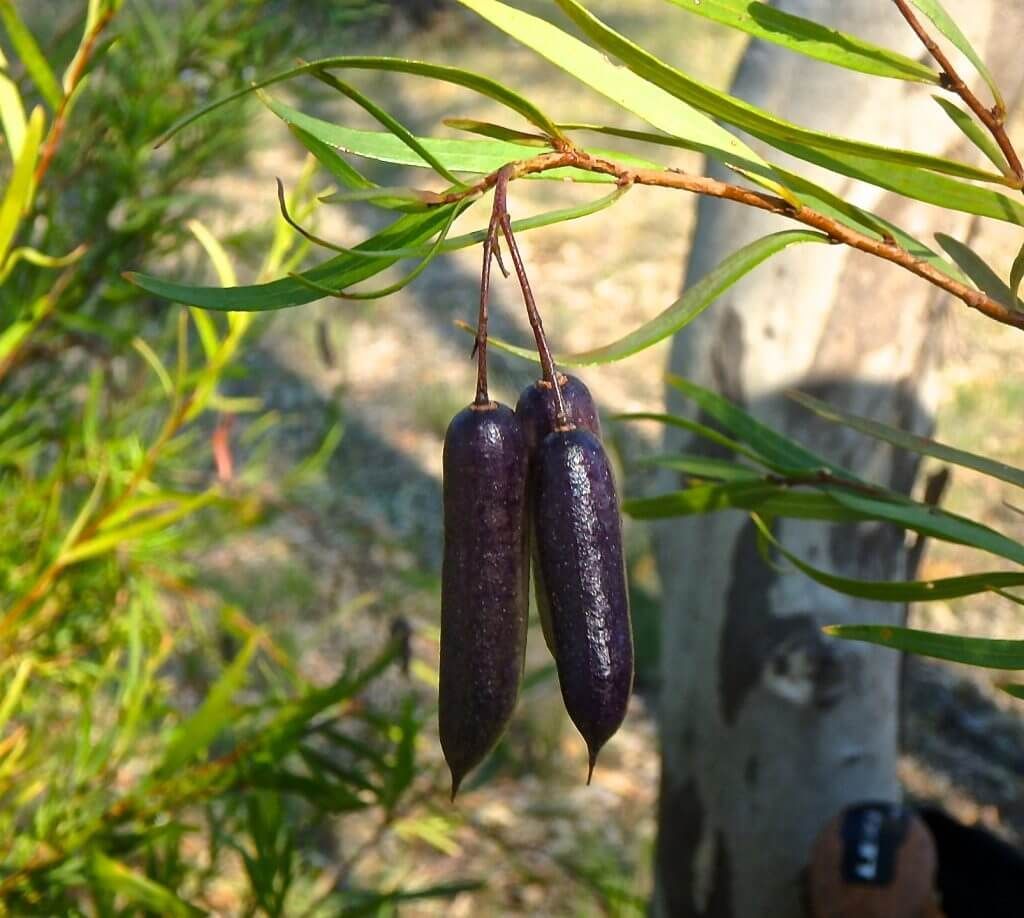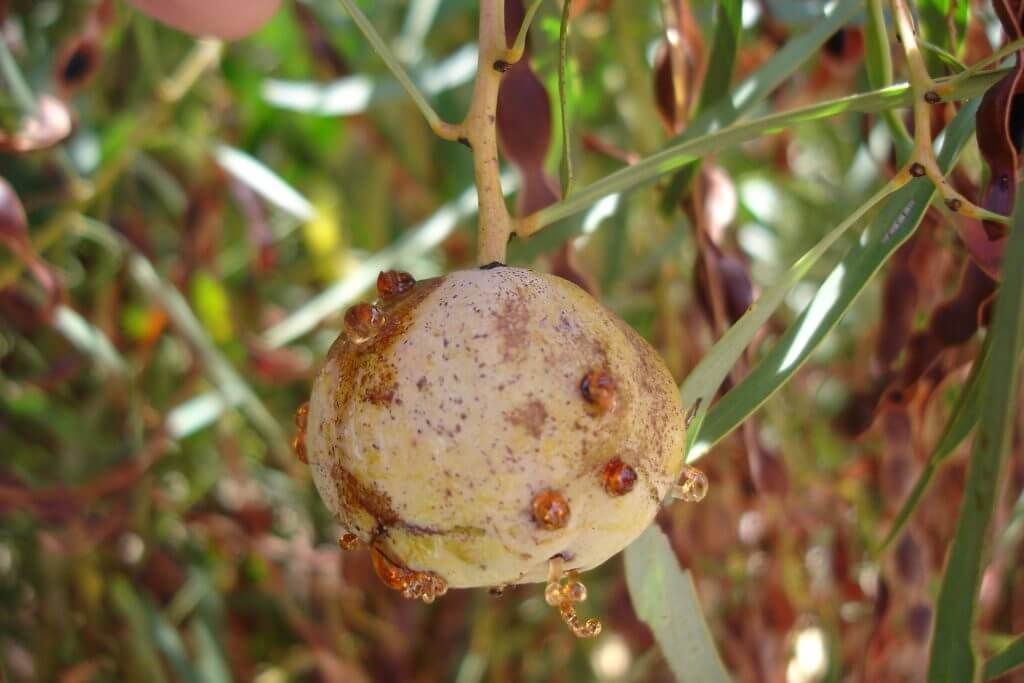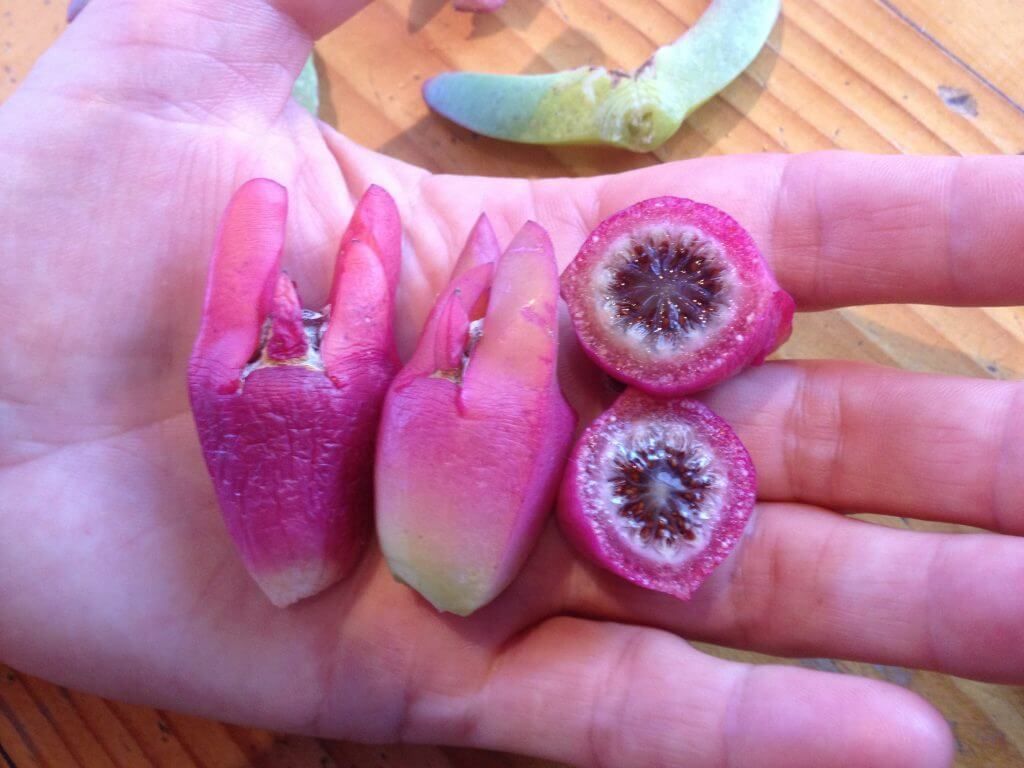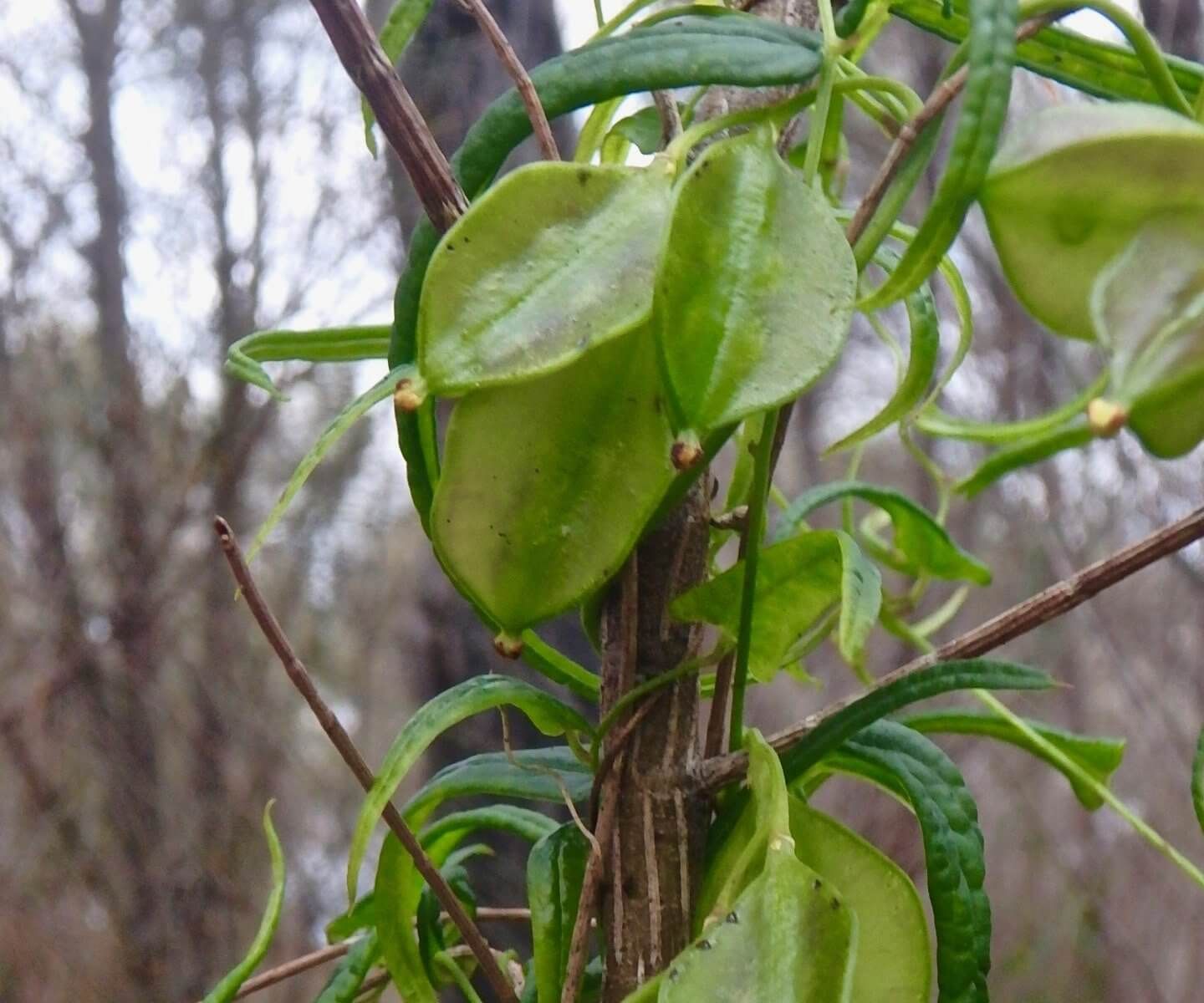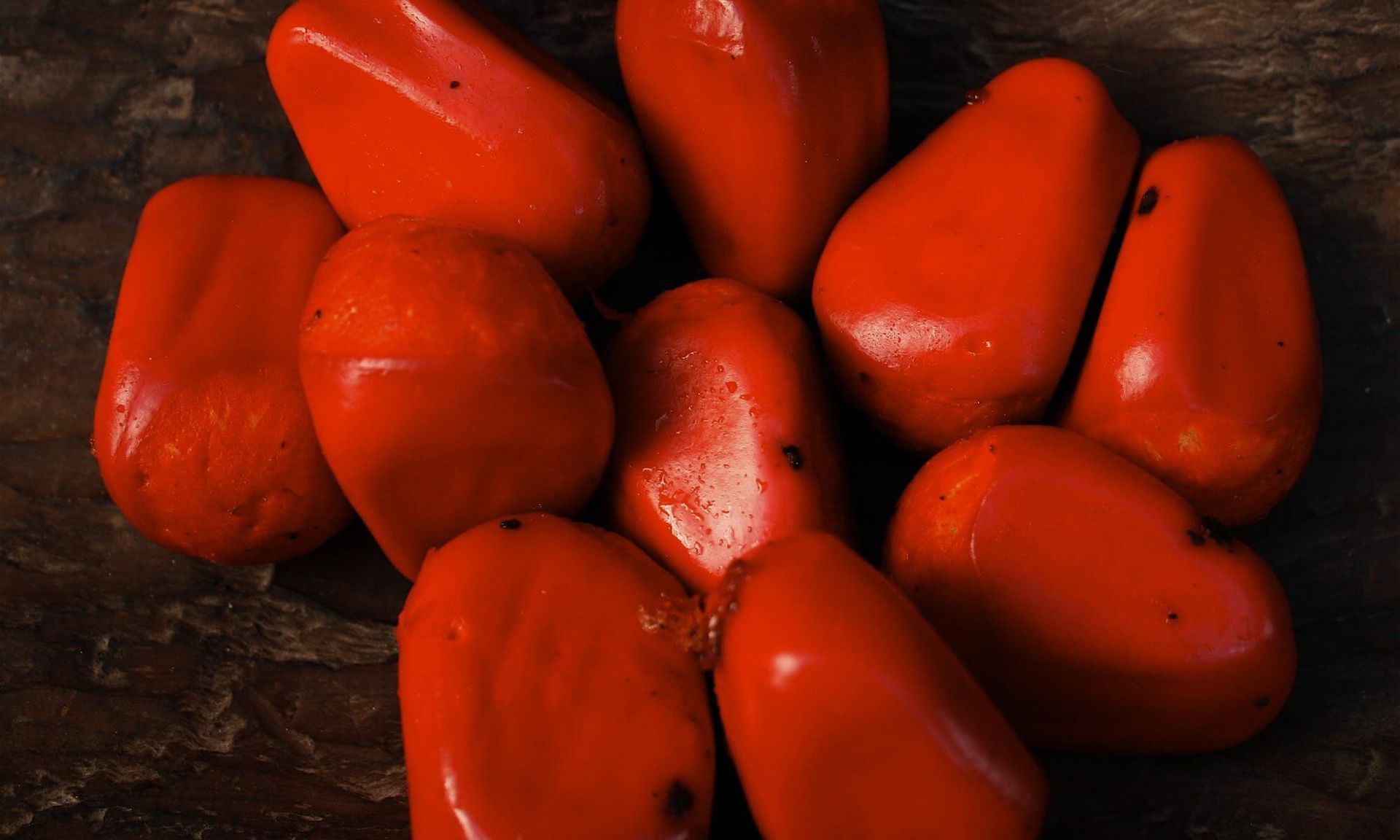The Sweet Gum – a Nyungar confection
Prepared by Ken Macintyre and Barb Dobson
Research anthropologists
‘menna – The gum of one species of acacia, which is sometimes prepared by being first pounded, then mixed with spittle, and made into a ball, and, finally, beaten into a flat cake, when it is kept by the natives as a provision against a time of want. It is considered good, and is found to be very nourishing.’ (Moore 1842:52, 72)
Few colonial observers recorded in any detail the traditional uses and indigenous methods of collecting the gum and seed of Acacia (wattle) in southwestern Australia. Indigenous knowledge was not considered important even though Acacia gum or gum arabic (as it was commercially known) was a highly valued and sought-after product in Britain and Europe.1 The sweet smelling wood of the raspberry jam wattle also had a high value on the British market and was seen as a potential substitute for sandalwood. We do not understand why the colonial entrepreneurs did not exploit the valuable indigenous knowledge that existed and was available to them at this time, especially when their fledgling enterprise, such as the aborted gum venture of 1836, failed due to a lack of relevant cultural information.
The early ethnohistorical records are often vague when it comes to the actual time of year and seasonality when certain coveted food products, such as the menna gum or galyang as it was also known, were collected. James Drummond, the colonial botanist, exemplifies this lack of specificity in his accounts when he informs us that the “manna” gum is available ‘in the dry season.’ Sadly, few colonial accounts provide us with sufficient details on the seasonality, nutritional value and animal or plant phenological cycles to give insight into the science of indigenous food collecting, preparation and consumption. Using the limited ethnohistorical information that is publicly available, together with reasoned anthropological imagination and analysis, we hope this paper provides some insights and discussion topics relating to the traditional Nyungar usage of Acacia gum and the esteemed value of this sweet tasting comestible even to this day. The desire for sweetness like the desire for fat not only constituted essential nourishment but like our own Western desire for sweetness was based on a sensation of pleasure, satisfaction and an essential source of energy. In hunter-gatherer culture energy dense foods (such as sugar and fat) were seasonally limited and highly valued.
Seasonal sources of sweetness in traditional Nyungar culture included the edible gums of Acacia and Hakea, the sweet nectar from the flowers of Banksia, Eucalpytus, Corymbia, Grevillea, Hakea, Callistemon and Xanthorrhoea and native fruits, berries, lerps or “honey-dew” (a Psyllid insect excretion found on the leaves of Eucalpyts), cambium root bark (twotta) and the sweet tasting flesh of young parrots fed on a nectarivorous diet. We touch upon these coveted sources of sweetness later in our paper.
‘We called it bush toffee’

Senior members of the Nyungar community to this day nostalgically recall eating the fresh gum of Acacia (wattle) as a type of confection or ‘bush toffee’ as they called it. They describe it as ‘very sweet tasting,’ especially the gum of the jam wattle (Acacia acuminata). When we tasted the gum of both Acacia acuminata and A. microbotrya that grow on our property at Toodyay, we found they tasted slightly sweetish but bland in comparison to the highly intense and concentrated taste of refined sugar to which we have become so accustomed. We would suggest that the perception of sweetness is a culturally relative phenomenon depending on the naturally occurring (or in our society unnaturally-occurring) sugar-producing substances within one’s environment. There is little wonder that when processed sugar was first introduced into Aboriginal culture it had a profound and addictive effect upon them. When Bates’ (1938) informant exchanged some mildly sweet tasting root bark for modern processed sugar, he immediately noticed its concentrated sweet taste compared to what he was used to.
Some colonial observations
‘Man-gart – the Greyiana [Acacia acuminata]; the wood of this tree has a heart nearly black, which gives out a most delicious perfume like raspberry jam, hence called by the colonists the raspberry jam tree.’ (Grey 1840:79)
‘Mang-art – Raspberry-jam wattle – so called from the fragrant odour of the wood. It is not found west of the hills [Darling Ranges] (Moore 1842: 69).
‘the Acacia styled by the settlers Raspberry Jam, in allusion to the smell of its wood (the natives call this tree Mangart)’ (Drummond July 25th 1839)
‘menna – The gum of one species of acacia, which is sometimes prepared by being first pounded, then mixed with spittle, and made into a ball, and, finally, beaten into a flat cake, when it is kept by the natives as a provision against a time of want. It is considered good, and is found to be very nourishing’ (Moore 1842:52, 72).
In 1836 John Septimus Roe, the first surveyor general of Western Australia, recorded in his field notebooks the names for jam tree (Acacia acuminata) as mungiet and menung (Roe in Hercock 2014: 238-239). Moore similarly records the names as mang-art and menna, the latter referring to the gum. Menna is also rendered as men (A.Y. Hassell 1894, Rae 1913) meen (Hassell 1936, 1975), men, mena, mina (Dench 1994), maynee (Roe 1836) and menna (Salvado 1851 in Stormon 1977).2
Stokes (1846) records minnung as the raspberry jam Acacia. This may be viewed as equivalent to Roe’s menung. The affix ‘ung‘ means ‘of, or pertaining to’ “men’ sweetness. Roe’s mainung wattle is interpreted by botanist Alex George as ‘probably Acacia microbotrya‘ (see Hercock 2014: 624). This species, known by Drummond (1843) as ‘the common Manna’ and verified to A. microbotrya by Maiden (1917) produces abundant quantities of gum. Some of the variant renditions above are attributed to species; others to the wattle or edible gum in general. The different renderings reflect regional variations or different orthographic transcriptions by the different recorders who were mostly untrained linguists trying to make sense of (what was to them) a totally alien language and culture.
Grey (1841: 294) mistakenly records kwonnat as the Noongar term for Acacia gum. He writes:
“Kwon-nat is the kind of gum which most abounds, and is considered the nicest article of food… In summer months the acacias, growing in the swampy plains, are literally loaded with the gum, and the natives assemble in numbers to partake of this favourite esculent.’
Kwonnat refers to the crushed seed of Acacia that is made into a kind of seed cake. It would seem that Grey (1840, 1841) misinterpreted his informant’s advice, possibly as a result of the fact that the timing of seeding often overlaps the production of gum as noted by Ethel Hassell (1975:19) who states
‘… in the hot summer months, they were seeding very profusely and exuding quantities of sweet gum.’
Menna – the taste of sweetness
It is our view that the variant names for gum and gum-producing wattles are indigenous emic descriptors denoting “sweetness” with respect to taste and smell. Words for sweet or sweetness in the Nyungar language include mena (Curr 1886) and also mungyt which according to Hammond (1933: 82) means ‘sugar, honey, anything sweet.’ Whitehurst (1992: 17) translates men as meaning ‘lips.’ Also the highly favoured sweet drink made from nectar bearing Banksia flowers is called mungit (or its variants mungyte, mungart, mungyt, mungaitch, mangyt, mang-ghoyte, moncat, mungitch, mungart). All these variant terms like mangart may be seen to denote sweetness. It would seem that the sweetness cycle in the Nyungar calendar reached its peak in late spring and summer when wattles were oozing gum and Banksia flowers (for example, B. grandis and B. attenuata) were in full blossom and being soaked and made into sweet drinks. Variations in climate, ecology, geography and other factors, such as the degree of insect predation on Acacia, would have influenced the local timing of these natural cycles.
Manna wattle, green wattle and raspberry jam wattle – where do they all fit?
Drummond (1839) highlights that Nyungar people used the gum of three different types of wattle for food: ‘the gum of the Manna, the green wattle, and Mangart.’ These are the gum of Acacia microbotrya (colonially known as manna wattle or manna gum), Acacia saligna (colonially called black wattle or green wattle) and Acacia acuminata (colonially, jam wattle or raspberry jam tree).
Moore (1842) specifies that menna is the edible gum of the raspberry jam wattle (Acacia acuminata). However, Meagher (1974) re-assigns menna to Acacia microbotrya, obviously assuming it to be a species-specific designation. Stokes (1846) describes minnung as the very abundant gum of the “Raspberry Jam Acacia.” However, Maiden (1917), the government botanist, re-assesses it to A. microbotrya. Hassell (1975:19) records meen as the edible gum of black wattle but she does not specify which species she is referring to. Acacia saligna was often called black wattle (or green wattle, Drummond 1839) by the early colonists but Meagher (1974: 83) for some unknown reason assigns Hassell’s meen, like Moore’s menna, to Acacia microbotrya as if assuming them to be a species’ name. We find this confusing as Hassell (1975: 21) refers separately to “manna gum” (Acacia microbotrya).
Hassell (1975: 19. 234) supplies a vivid ethnographic description of how Nyungar women collected and used the meen gum from black wattle (wuanga):
‘Now in the hot summer months, they were seeding very profusely and exuding quantities of sweet gum, which is a great source of food. When it is fresh and on young trees, it is like pure white sugar-candy, but on exposure becomes a beautiful clear honey colour, and is crisp outside but sweet, soft and sticky inside. I always liked it in that stage. On the older trees it is dark brown, very hard and not nearly so sweet. The lumps vary from the size of a large pea, to as big as the handle of a door. This gum is excellent for sticking purposes, and we never thought of using paste; so we always kept a big bottle of gum handy. When the women gather this gum or meen as they called it, the pieces near the bark are soft and sticky. They press the lumps together and make large, round balls, about as big as a child’s head, and keep it for use. When wanted for food, pieces are knocked off and sucked, or it is warmed by the fire when it becomes soft, and lumps are broken off and chewed’ (Hassell 1975: 19).
The manna/menna confusion
‘Acacia called Manna by the natives, which produces a great quantity of gum resembling gum-arabic in the dry season, forming an important article of their food… common in the valley of the Avon.’ (Drummond 1843) Letter No. 16, 19th April).
It would seem that Drummond may have misheard or misinterpreted his informants’ menna as ‘manna.’ At first glance ‘manna’ looks like an anglicised version of the Nyungar term menna but a deeper analysis shows that manna has Arabic origins where mann denotes the exudation of the tamarisk and its Latin or Greek derivations describe the sweet secretion from the manna ash or similar plant. Early recorders in southwestern Australia, including Drummond and Hassell (1975: 21) refer to the sticky wattle exudate eaten by Nyungars as manna gum. However, this colonial term is confusing for in Eastern Australia ‘manna gum’ has a very different meaning. As noted by Maiden (1917):
‘The term ‘gum’ and especially ‘Manna gum’… is usually applied to a more or less smooth barked eucalpyt in Australia, and the manna gum of the Eastern States are those eucalypts which yield, either from leaf or trunk, a sugary secretion called manna’ (Maiden 1917).
The ‘manna gum’ as applied to the wattle in Western Australia and identified to Acacia microbotrya ‘has arisen through a species of acacia producing an amount of mucilage gum above the average of the wattles of the West’ (Maiden 1917). We would suggest that in order to eliminate the confusion between manna (a non-indigenous term) and menna (a Nyungar-derived term), that menna be used in southwestern Australia to denote wattle gum rather than the colonial ‘manna gum’ to give recognition to, and indeed highlight, the Nyungar-derived etymology of this term. It is our strongly held view that menna (and its variants) is not a species-specific designation but is more likely to have been a collective term for the edible gum of several species of wattle.
‘It’s ironical that as we believe menna to be a general term for sweet Acacia gum that the colonial term “manna” should also be a term for edible gum in general’ (Dobson 2016).
Galyang – wattle gum
Another name for ‘the wattle tree’ and its edible gum is galyung (Grey 1840: 40). Moore (1842) with a slight alteration in the spelling describes it as:
‘The gum of the Galyang, or wattle tree, eaten by the natives. It is soluble in water, and is one of the best gums in the country for all common purposes.’ (Moore 1842: 27)
Grey and Moore do not attribute galyang to a species. Ten years earlier Lyon (1833 in Green 1979: 171) records galung as “Acacia – green wattle.” This is most likely a reference to Acacia saligna which was colonially known as green wattle or black wattle. Stokes (1846: 132-133) records kil-yung as black wattle (kil-yung being a variant of galyung) and yet Meagher (1974: 59) assigns Moore’s galyang to Acacia microbotrya in the same mysterious way that she re-assigns Moore’s menna from Acacia acuminata to A. microbotrya. Her unscientific re-classifications have influenced many researchers, including Abbott (1983) and Bindon (1996: 22) who also classify to species kalyang as exclusively Acacia microbotrya. This is confusing from an ethnobotanical point of view. It makes us wonder whether galyang is a reference to an Acacia species or once again a generalised descriptor referring to the edible gum, possibly when the exudate is fresh and found on young trees. The closest meaning that we could find to galyang (or galyung) is gulang (to chew) or gulangin (chewing) (see Moore 1842: 93). It is our view that galyung describes how the fresh gum was sucked and chewed. We see this as a situation where the indigenous person is explaining to an outsider how to consume this relished item of food.
What was important to the indigenous collector was the plant’s products (edible gum, seeds, wood for artefacts, habitat for edible grubs or medicinal value). For this reason a plant often has more than one recorded name, depending on which aspect of the plant or product was being described and at what season. These descriptors were usually based on practical considerations or sometimes mythological or totemic referents but, contrary to popular assumptions, they did not follow the Western-derived Linnaean classificatory model. It is not surprising that recorders, researchers and ethnobotanists often disagree as to which species’ Nyungar plant names, for example, ‘the galyang, or wattle tree,’ or menna gum should be assigned. The species’ name microbotrya derives from the Greek –micros meaning ‘small’ and G. botrys ‘bunch of grapes’, referring to the flowers whereas the name acuminata derives from the Latin acuminatus meaning ‘drawn out to a long narrow point’ (Sharr 1996: 80) referring to the plant’s phyllode or leaf structure. The species name saligna derives from the Latin salignus ‘of willow wood, resembling a willow (Sharr 1996: 193). These distinctions between species based on floral or phyllode (leaf) structure, or willow-like resemblance, have no cultural relevance to a traditional indigenous hunter gatherer society whose main focus was on survival. Nyungar people had already developed their own independent, culturally logical, appropriate, practical and utilitarian classificatory and descriptive animal and plant nomenclature system tens of thousands of years before the Linnaean system was introduced to Europe.
Badjong – gum export trade from Toodyay to Britain
Another name for wattle gum recorded by Drummond during an excursion to the Dandaragan area is badjon. He describes an Acacia species that
‘comes near the common Manna, in botanical character, but the leaves are longer and narrower, and the seeds are much smaller; the tree produces large quantities of a gum called badjon by the natives, and which forms the principal article of food for them during the dry season.’ (Drummond 1853).
The term badjon (Drummond 1853) is also rendered as badjong (von Mueller in Abbott 1982: 6), padjang (Preiss 1844 albeit referring to a different species of Acacia), badjong (Western Mail 1917) and paadyan (Von Brandenstein 1988:44). Moore (1842) gives us a clue to the etymology of this term when he describes badjang as the ‘matter from a boil or sore.’ In this context badjong may be seen as a metaphor which likens the oozing of gum to the oozing of pus from a festering sore. It is a graphic descriptor which we believe applies to wattle gum in general rather than to a singular species. It makes us smile to think that our colonial forefathers unwittingly had adopted as a brand name for their wattle gum export “badjong” which when translated referred to a suppurating wound. Badjong became adopted as the colonial term for wattle gum.
Drummond recognised the export potential of this valuable gum:
‘The glaucus leaved Acacia or gum wattle of the settlers, the native manna is common in the valley of the Avon, and produces a large quantity of gum which might probably answer to collect as an export.’ (Drummond, 1843 Letter No. 13 to the Editor of the Inquirer, 6th March).
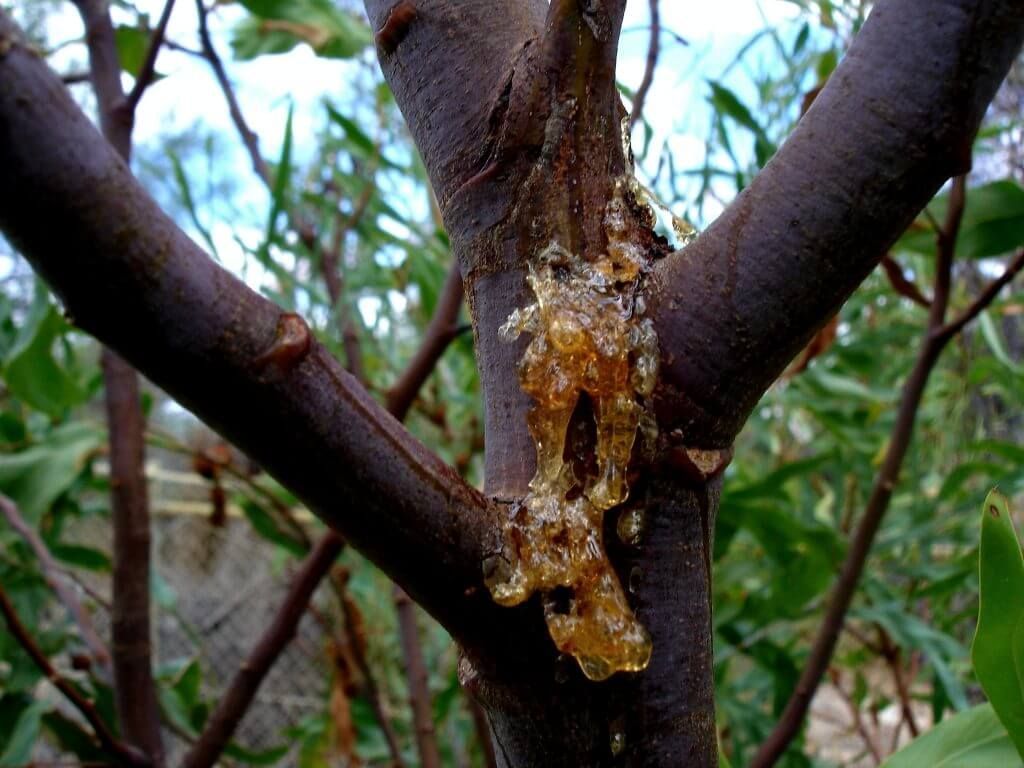
Writing in 1857 Bradshaw (1857:100) states that:
‘During the summer months the natives collect quantities of fine gum which they make into cakes, it is equally as good as gum arabic; several tons of it has been sent to England.’
An article in the Western Mail (1917) describes how in 1851 a quantity of Acacia gum under the name badjong was collected in the Toodyay-York area and exported to Britain as a substitute for gum Arabic. Drummond, who resided at Hawthornden Farm in the Toodyay Valley would no doubt have been involved in this venture.
We can only wonder whether the badjong collected from the Toodyay-York area was exclusively that of the prolific gum-producing Acacia microbotrya “the common manna” or whether other species were also involved, such as Acacia acuminata or A. saligna that are also found in this region. We could find no information as to the success or failure of this gum trade and how long it lasted. But it was not the first attempt by colonial entrepreneurs to export Acacia gum from the Swan River colony to Britain.
There is historical evidence that Acacia gum was one of the first exports from Western Australia for the production of gum Arabic which was used for all kinds of purposes including glue making, waterproofing of maps, varnish and paint production. It was in high demand in England and Europe.
According to an article in The Perth Gazette and the Western Australian Journal (Saturday 1836, June 18, 1836, Ref. 712) the collection of wattle gum was one of the first commercial ventures ever attempted at the Swan River colony using an indigenous product and indigenous labour to source it. The project was unsuccessful as only a ‘very inconsiderable’ amount of gum was collected:
‘The quantity of gum brought in by the natives to Mr Armstrong, Interpreter to the Natives, in exchange for one-fourth of its weight in flour, is very inconsiderable. We should like to see the experiment tried in the interior, where it will be found in greater abundance. The management of the scheme could be entrusted, we think, with advantage, to the several Government residents. Is the remuneration inadequate to the time and labour bestowed ‘by the natives’ in collecting gums in the neighbourhood? If so, a revision of the plan cannot be too soon adopted.’
There could have been a number of reasons why this project failed. For a start from an indigenous point of view there would have been little reason for them to collect vast quantities of gum because the reward, a small quantity of flour, would have been sufficient to satisfy their immediate needs. Here we have an early clash of values – that of a white settler capitalist economy geared towards surplus and profit versus a subsistence hunter-gatherer value system. Also the timing of gum collection is not specified. Given the newspaper article is dated mid-June 1836, this might suggest that the gum was being collected out of season. Acacia gum was traditionally collected during the dry season. We are not told from which species of Acacia the gum was collected. If it was in the Perth area, it was probably Acacia saligna (see photo of Acacia saligna gum above). Gum yields are highly variable depending on weather, fire history, insect infestation, fungi attack, age of plant and species (some produce gum only once every two years). The traditional gum collectors probably had other cultural demands on them at the time assigned to them by the authorities to collect gum. A critical factor in our view may have been that the colonial scheme did not involve Nyungar women (who in the early colonial period were kept behind the scenes, away from white colonial males) yet gum collecting was a predominantly female activity. Indigenous male or female gender-based roles were probably not even considered in this short-lived endeavour. All or some of these factors may have explained the failure of this Western Australian colonial commercial venture.
Was there human intervention in the process of gum production?
The production of Acacia gum usually results from damage to the tree:
‘Although the production of gums in plants is not well understood, these substances often accumulate in response to stress, injury, or bacterial, fungal or insect attack on the plant (Esau 1965).’
In some of our discussions with Aboriginal people from different parts of the state, including the northern Goldfields, eastern Goldfields and the Wheatbelt area of western Australia, gum production was sometimes encouraged by anthropogenic intervention where women with sharp digging sticks would injure the bark of Acacia to encourage the seasonal flow of gum exudate. We could not ascertain at what time of the year this took place but we would imagine that it was early to mid-spring.

Traditional and contemporary Nyungar uses of gum
Season of gum collecting
Drummond (1839) notes that the season for collecting mangart gum is ‘in the dry season’ and likewise Hassell (1975) ‘in the hot summer months.’ Based on our own observations in the Toodyay-Northam area the gum exudate from A. microbotrya is more abundant than that of A. acuminata. We have noticed mature A. microbotrya gum appearing as early as mid-October through to mid-December and we have observed the gum of A. acuminata in December/ January. The Nyungar people according to Hassell collected the gum as it became available, from the manna, black wattle and raspberry jam tree. When it was collected in large quantities it was stored in large round balls (Hassell 1936, 1975) or ‘beaten into a flat cake’ (Moore 1842: 52) for later use.
‘It forms in soft sticky lumps gathered by the women and pressed into large, round balls. When wanted for food, lumps were knocked off and chewed. They were sometimes heated until soft before the pieces were detached.’ (Hassell 1936: 689).
Acacia gum as a confection or food additive
Acacia gum was a popular indigenous food confection consumed in quantity in season. Even to this day Nyungar Elders still collect and relish its taste, calling it ‘bush toffee.’ According to Moore (1842) and Drummond (1843) the gum was storable, portable and a principal item of food carried by women in their bags (goto) for use during the dry period. During food preparation the wattle gum was often added to non-bulky vegetable materials, such as the pounded roots of Haemodorum (bohn), root bark (twotta) and the processed Acacia seed mixture known as kwonnat (or quonert). This gum provided extra sugars and carbohydrate and its mucilaginous and demulcent properties made it easier to digest tough cellulose substances. It was not only a taste enhancer but also a dietary filler or bulking agent giving the consumer a feeling of physical and psychological satiation, especially in times of food shortage – see our paper on indigenous geophagy http://anthropologyfromtheshed.com/geophagy-the-earth-eaters-of-lower-southwestern-australia/ and root bark eating http://anthropologyfromtheshed.com/root-bark-eating-in-southwestern-australia/
Acacia gum as a bush medicine
According to our field consultations with senior Aboriginal women from the York-Northam area in 2000, wattle gum was (and still is) an effective bush medicine. When mixed with warm water it becomes a demulcent that can be used to soothe inflamed throats and coughing. It could be used either as a lozenge or cough mixture. It was one of the main treatments for a variety of gastro-intestinal conditions including stomach ache, indigestion and gas bloating. Whitehurst (1992: 39), a Nyungar linguist, remarks that the sap or gum of the jam tree (mangart) is ‘good for wind.’
A senior female Nyungar spokeswoman told us that wattle gum was effective in the treatment of diarrhoea and dysentery, especially in children. She said the sweet tasting gum of the jam wattle was a preferred choice if it was available. Part of the reason for its efficacy may have been its reputed sweeter taste and relative scarcity. Wattle gum continues to be used for food and bush medicine by Nyungar people today.
Acacia wood used for artefacts
The Elders emphasized that jam wattle wood was used for making a range of traditional artefacts, including the wanna (digging stick), gidgee (spear), dowak (club) and the iron-hard barb near the tip of their spears that was bound on tightly with tail sinews from the kangaroo.
Moore (1842: 78) records “Wonnar – a species of spear-wattle found in the hills.” It would seem that he mistook wonnar to be a species of Acacia rather than the name of the wooden digging stick (wonnar) that was made from the hard wood of this tree. ‘Spear-wattle’ is one of the colonial names for Acacia acuminata. Moore (1834, 1842: 12) describes how the kylie (boomerang) and bonjun ‘a native knife, with a polished handle of the raspberry jam-wattle…’ were made from this ‘scented wood tree.’ He states:
‘Of the wood of this tree, is frequently made the curved weapon for throwing, which always retains its delicious fragrance.’ (Moore 1834 in Schoolbert 2005: 344).
Modern industrial uses of Acacia gum
Acacia gum (or gum Arabic as it is commercially known) is commonly used in the preparation of foods and drinks. It is used as an emulsifier and stabiliser and has been likened to an edible glue. It is also used in the pharmaceuticals industry:
‘Gums are employed in a number of medical uses including emulsifiers and suspending agents for pharmaceuticals, as antiseptics, bulk laxatives, in pills and tablets, as a replacement for gelatin in capsules, for preparation of time release capsules, and even as blood substitutes in some situations.’
Other traditional sources of sweetness
Sweet substances were highly prized. Seasonal sources of sweetness traditionally include the edible gums of Acacia and Hakea. Moore (1842: 34, 97) records the name of the Hakea gum eaten by the Nyungar as “dulgar’(p. 34) or tulga (p. 97). Also the sweet honey or nectar from the flowers of Banksia, Eucalpytus, Corymbia, Grevillea, Hakea, Callistemon and Xanthorrhoea were all relished when in season.
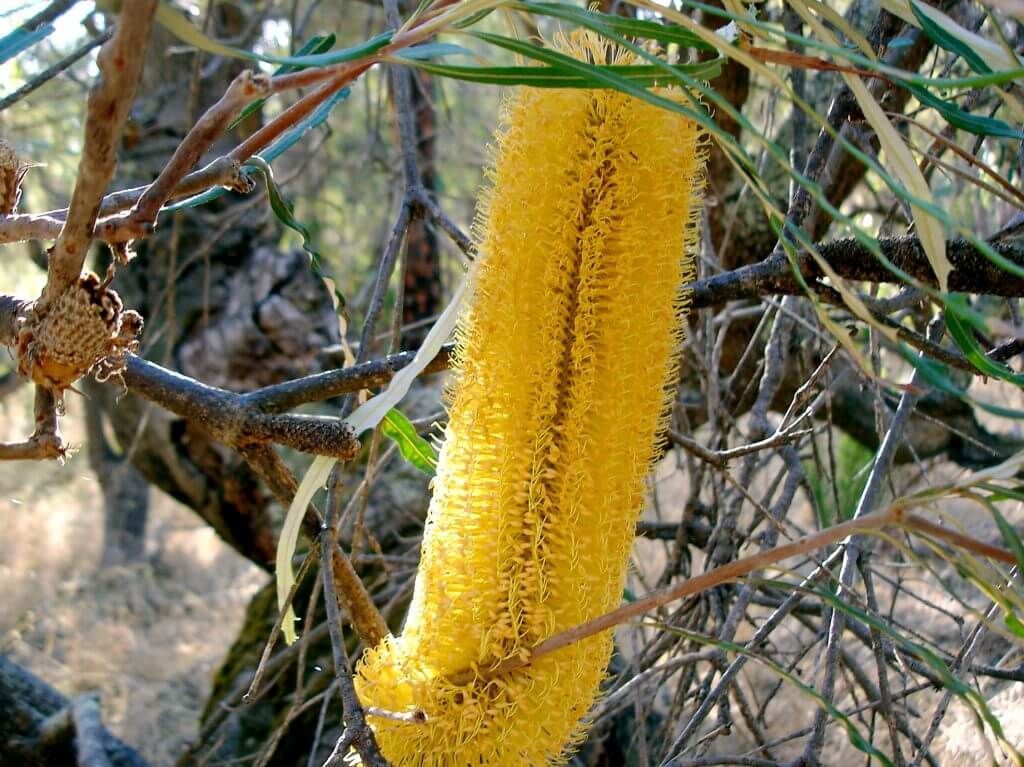
Nectar from Banksia blossom was sucked or soaked in water and made into a sweet drink called mungit (or mungyt, mungaitch, mangyt, mang-ghoyte, moncat, mungat or mungitch). Roe (1848 in Hercock 2014: 454) refers to the ‘honey bearing banksia, so prized by the natives during its flowering season’ as “mungart.” Moore (1842: 69) points out that ‘One flower [of mangyt, Banksia] contains at the proper season more than a table-spoonful of honey.’ Moore’s mangyt or Roe’s mungart referring to nectar-bearing banksia flowers is similar if not the same as mangart referring to raspberry jam wattle with its sweet-smelling wood and sweet-tasting gum. Curr (1886) records mungitch and mangite as meaning ‘sweet.’
The Nyungar term nugoo recorded by Meagher (1974) for the nectareous flowers of Banksia sphaerocarpa also translates to ‘sweet’ according to Curr 1886 (ngugo or ngok, sweet). There are many names for Banksia depending on which aspect of the plant is being referred to and at what season. Its common name bool-galla (or pul-kalla) literally means ‘plenty of fires’ (bool, plenty, much + kalla, fire). The large dried cones of this tree were commonly used as portable fire-sticks (kalla-matta, literally ‘fire legs’). Other names recorded in ethnohistorical sources include koolyanga (swamp banksia, Isaacs 1949), doo-barda “a species of Mungyte” (Grey 1840: 30), bealwra (Stokes 1846) and beara (Grey 1840:8). The nectareous flowers of some Eucalpytus, Grevillea, Calothamnus and Callistemon were also sucked or soaked mungyt-style.
Daisy Bates notes that only men collected the banksia nectar (see our paper ‘Notes on the Nyungar traditional useage of Banksia’ forthcoming).
Grey (1840: 107) records ngon-yung as ‘a species of flower called the honey flower.’ Moore (1842: 92) alters the spelling slightly and records ngon-yang as ‘The honey or nectar of flowers; sugar.’ He notes that it includes (but is not restricted to) the flower of the Budjan which he says “abounds in honey.”
Other sources of seasonal sweetness included animal and bird by-catch which provided a valuable source of fat and protein. For example, the sweet tasting flesh of young parrots fed on a nectarivorous diet of Banksia flowers and sweet tasting possums fed on Banksia and Acacia flowers. Both were prized delicacies. Hassell (1975: 20) highlights that Aboriginal people valued the raspberry jam tree
‘because the flowers were the favourite food of the opossums, and they could always rely on getting plenty of them, nice and fat, when the munet was in bloom.’
Also relished were native fruits and berries, cambium root bark (twotta) and lerps or “honey-dew” known as womela. This describes a white waxy substance, found on the underside of Eucalpyt leaves and branches, that was consumed by Nyungar people. In the Perth region it was known as dangyl (Moore 1842: 25, 103).3 The term dangalyaneen according to Lyon (1833) means ‘sugar.’ The Nyungar Elders that we spoke to said that they had always called it womela.
Moore (1842: 103) records waumilyar as:
‘A white, sweetish substance, found on and under certain trees and plants, supposed to be some insect secretion. It is much prized by the natives. Birds feed upon it, and are in excellent condition during the season when it abounds. When the native women find a quantity of it collected about an ant-hill, they fling the furry side of their cloak upon it, to which it adheres. They then carry off the cloak and secure their prize, the ants having dropped off the fur in the meantime. At Perth it is called Dangyl.’
According to Moore (1842: 54) kamak is ‘a small kind of Kuruba, found in the York district. Kuruba is defined as:
‘the fruit of a creeper eaten by the natives. It is of a long, slender, ovate shape, and when roasted in the fire is of a pleasant slight lemon-peel flavour. It is one of the very few things which can be considered as approaching to an indigenous fruit.’ (1842: 63)
The purplish sap of the Yate tree was savoured by Nyungar people in the Jerramongup area, according to Ethel Hassel, who writes:
”…the Yate tree is a species of Eucalyptus which they obtained by stripping pieces of bark from the wood of the tree and scraping up the sap which is a thick purplish syrup and very sweet. This they used to carry in baskets made from bark, curled at the sides and bent up at each end. They often eat this syrup like honey, and said it was very nourishing. I have frequently eaten it and it tastes like a mixture treacle and honey.” (Hassell 1975:21)
In this paper we have touched briefly on some favoured sources of sweetness in the traditional Nyungar diet. Acacia gum was by far one of the most important nutritional substances. It not only provided a sweet taste and energy source but its soluble dietary fibre, serving as a demulcent, enabled people to eat substances during times of scarcity that were unappetising and difficult to digest. This valuable gum was (and still is) a beneficial natural ethnomedicine. We only have a very limited knowledge of the traditional usage of Acacia gum in Nyungar culture and we hope that in time reconstructive anthropology and archaeology may fill in some of the gaps of our knowledge.
To conclude it is our strongly held view that Nyungar names for gum such as menna, galyang and badjong are not Linnaean species-specific terms, as is often assumed, but are cultural descriptors about wattle gum in general referring to its taste, how it is consumed and how it resembles in appearance a suppurating wound.
ACKNOWLEDGEMENTS
We would like to acknowledge and thank all the Nyungar Elders who have assisted us over the years by providing anecdotal and cultural information on the history and usage of their traditional foods and medicines. We would especially like to thank Mrs Gwen Corunna and daughter Vanessa for their advice on the medicinal qualities of Acacia gum.
Annotations
1. Chemically, gums are water soluble or dispersible complex carbohydrates. ‘In the broad sense, gum arabic is almost any gum which dissolves completely in water to form a sticky mucilage’ (Mantell 1947: 21).
2. Hassell’s (1975) terms manet, munert and manet appear to refer to the raspberry jam wattle, also known as mungiet (Roe 1836), manjart (Preiss 1844) and mangart (Drummond 1839, Grey 1840 and Moore 1842).
3. The term dangyl used in the Perth area to refer to this sweet substance is probably a derivative of the term dangoolyaneen which Lyon (1833) records as the indigenous term for “sugar.”
BIBILOGRAPHY
Still in progress.
Drummond 1843 Letter No. 16 (19th April).
Drummond, 1843 Letter No. 13 to the Editor of the Inquirer (6th March).
